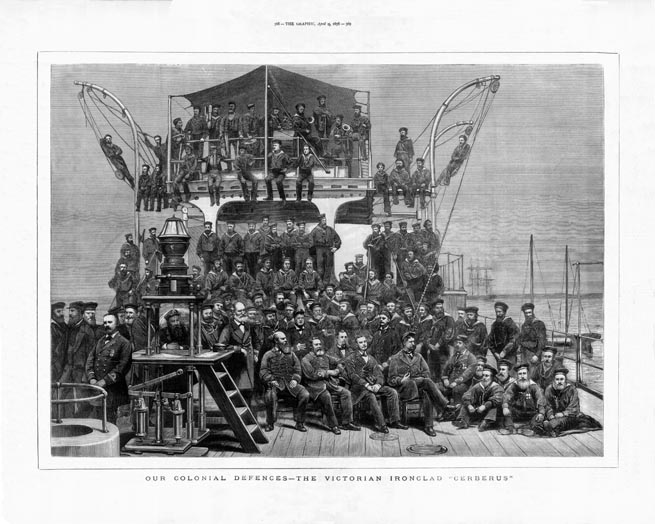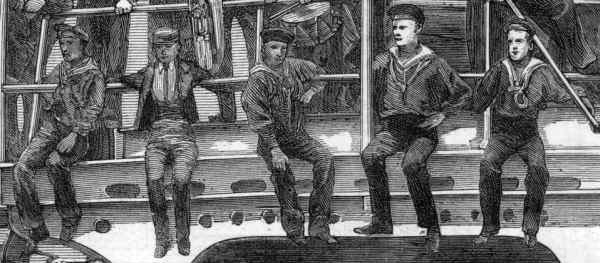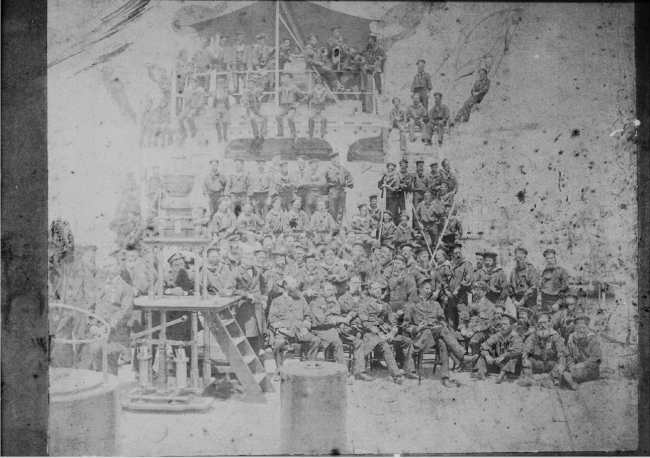 |
Cerberus Crew in 1878
We believe that Captain Mandeville is the 3rd seated officer from the left in the front row.
Engraving courtesy of John Trewarne.
Click image to enlarge.
The last paragraph of the text that accompanied the engraving below, which reads "Our engraving is from photographs kindly furnished by Mrs. Mandeville, St. James's, Tunbridge Wells. ", tells an interesting story. It would appear that Captain Mandeville, who took over command of the Victorian Naval Forces in July 1877, was so proud of his new ship that he had a photo taken of the crew and sent it "home" to his mother in Britain.
Due to a Cerberus log book entry, it is possible that the photographs that Captain Mandeville sent to Mrs Mandeville in Britain were taken on the 18th of February 1878.
 |
Attention has of late been seriously directed to the unprotected condition of our colonial ports in case the mother country should be involved in war. The Australian colonies are especially deserving of consideration in this respect, because, as in proportion to the extent of the coast-line the harbours of Australia are few in number, an active enemy might, even without venturing on any offensive movements, cause immense loss and suffering by simply blockading the ports. Thus Port Jackson, on which Sydney, the capital of New South Wales, is situated, is practically the only outlet of importance for the entire colony; and the same observation applies even more forcibly to the colony of Victoria, as Melbourne and Geelong, the two chief seaport towns, are both situated on the shores of Port Phillip, which, although in itself a wide expanse of water some forty miles across is approached from the sea through a narrow neck scarcely a mile in width.
A colony thus situated, and unprovided with either ships or forts, might evidently, as far as its seagoing commerce is concerned, be held at the mercy of a single hostile vessel. Of late, however, the Victorians have been aroused to a sense of their danger, and although, in consequence of the laying aside of the Forts and Armaments Bill, it has not been possible to carry out the whole of Sir William Jervois' report relative to the defence of Port Phillip Heads, nevertheless steps have been taken to put the port into a better state of defence.
The Cerberus, ironclad turret-ship, was purchased last year by the Victorian Government. She is now under the command of Captain Colebrooke Mandeville, lately retired as Commander from the Royal Navy, and has a full crew on board. She was recently inspected by Commodore Hoskins, R.N., who was satisfied with her efficiency. The line-of-battle ship Nelson also is to be cut down so as to make a frigate of her, in which case, as her draught of water will be reduced, she will be much more useful than she is now, and will be able to take an active part in the defence of the port. The batteries at the Heads, are also being strengthened; two 12-ton 9-inch guns having been sent down to Queenscliff, together with four 80-pounder Armstrong guns. The two heavy guns will be placed in position so as to command the entrance to the Heads as far round as Point Lonsdale; while the 80-pounder guns will take the place of the lighter ordnance now in the batteries.
Our engraving is from photographs kindly furnished by Mrs. Mandeville, St. James's, Tunbridge Wells.
John Underwood's keen eye noticed what appears to be a female member of the Cerberus crew in 1878. Of the five crew members sitting on the end of the Flying Deck, the second person from the left appears to have a woman's body shape. This is the only person who has broad hips and is wearing a uniform unlike that of anyone else.

Although hundreds of women served in the Royal Navy during the Napoleonic Wars, Victorian morality and the difficulty of disguising oneself in the tighter uniforms introduced in the mid 1860s made this increasingly rare. Viewers can decide for themselves whether the person shown could be a female. Thanks John for pointing this out to us.
A scan of the photograph from which the engraving was made (below) was supplied to us by the Museum of HMAS Cerberus. It goes without saying that we would love to obtain a better copy of he photo and names of any of the men in it.
